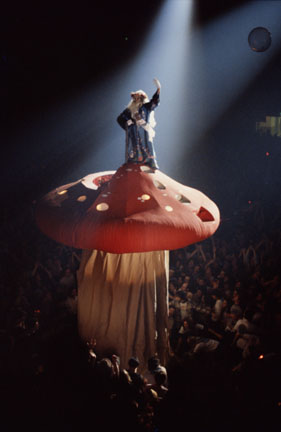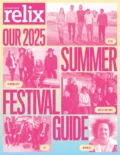
Bill Graham as Father Time on New Year’s Eve 1988
In the early days of the Fillmore Auditorium, Graham did not even have his own permit for the venue. He got his start using the dancehall permit of African American entrepreneur Charles Sullivan. Sullivan was putting on jazz, blues, and R&B shows in the predominantly African American neighborhood. Eventually Graham got his own dancehall permit, and continued to put on shows that mixed rock bands with African American artists. Young, stoned hippies would come to see psychedelic rock bands like Jefferson Airplane, and wound up dancing their hearts out to Motown acts like Martha and the Vandellas. Graham even helped revive the career of the legendary BB King by exposing him to white audiences. When King saw the response of all the kids dancing to his music, he cried. There were no limitations in the mind or heart of Bill Graham. The synergistic combination of diverse acts made him a unique promoter. He knew what would work, and what would not. More than that he recognized the bands and fans as a community which supported each other.
In 1968 Bill Graham moved to the Carousel Ballroom. The original Fillmore Auditorium was falling apart and it was time for a change. He renamed this new building Fillmore West. In the same year the Fillmore East in New York City opened up, and Graham would fly between the two venues every week.
One night at the Fillmore West a guitarist failed to show up for the gig. Graham asked if there was a guitarist in the audience, and the young man who volunteered was Carlos Santana. After the show Graham said something along the lines of, “Hey man, you should really start a band”. At the time Santana played with the Santana Blues Band. So, from that point on, Bill Graham managed Santana. When Woodstock came around Bill Graham helped advise the folks that produced the festival. The only payment he wanted was to put Santana on the bill, and the rest is history.
The music gained momentum and exploded in the seventies. Bands wanted more money, they had agents, and egos. Graham did not want to deal with all the demands and shut down the Fillmore East and West in their peak in 1971. He said he wanted out of rock ‘n’ roll. This lasted a mere six months; Graham just could not stay away. This time around he put on shows at the Winterland Arena in San Francisco. Momentous events like The Last Waltz-the final concert for Bob Dylan’s band, The Band- was filmed there. Every New Year’s there would be a rowdy Grateful Dead concert and at the stroke of midnight Bill Graham would come out in a wild costume. One year he was a chicken and laid an egg.
After about seven years, Bill shut down the Winterland Arena. The last hurrah was one of the infamous Grateful Dead New Year’s shows in 1978. The venue was in its prime, but at least it ended on a real high and groovy note. Even after Winterland shut down, the Grateful Dead New Year’s bonanzas grooved on. In 1988, Graham dressed up as as Father Time, wore a wizard outfit, and rode around on a giant mushroom. It is said the Grateful Dead always tried to dose Bill Graham with LSD. They may have gotten him…a couple of times.
Throughout the 80s, Graham focused his energy on putting on massive benefit concerts. At this point the bands that were once playing in living rooms, had now reached stadium audiences. Though he had never desired to put on stadium productions for obvious reasons of sound quality and overall fan experience, it was in a way inevitable. The fact that the music grew in this way, however, is no less than incredible.
One day in 1991 Bill Graham went to a Huey Lewis concert. The weather was terrible and despite being warned not to fly, Bill was always in a hurry. His home was just thirty miles from the venue. The helicopter flew into an electric utility tower, exploded, and in that moment the lights dimmed in the concert. No one knew that this was the moment, that Bill Graham died.
In a matter of days a tribute concert was organized in Golden Gate Park, for a gathering of Laughter, Love, and Music. Nearly half a million people came, and many of the artists who had known Graham since the start like the Grateful Dead, Carlos Santana, and Crosby Stills Nash & Young performed in his honor. He was after all, no less than legendary himself.
At the 5th annual Bridge School Benefit, the same week as the memorial, Neil Young dedicated a special instrumental version of his song, ‘Greensleeves’, to Bill. After every single concert Bill would play ‘Greensleeves’ over the loudspeakers of his venues to ease people back into reality, to let them know, hey, it’s ok…to go home.


No Comments comments associated with this post